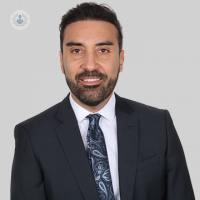An expert guide to coronary angiogram for heart attack and stable angina patients
Written in association with:Following a heart attack or a diagnosis of stable angina, a keyhole procedure to examine the extent of blockage of the arteries, known as a coronary angiogram, may be performed. In this expert guide to the procedure, highly respected consultant cardiologist Dr Pierluigi Costanzo, who specialises in interventional cardiology, details how a coronary angiogram is performed and how stents can be used to widen narrowing arteries. The leading specialist additionally offers insight on the importance of medication following this type of procedure and what patients can expect on the day of their treatment.

When is a coronary angiogram performed?
If you have been diagnosed with stable angina after an assessment of your symptoms and maybe some preliminary investigations, the cardiologist might schedule you for a procedure called coronary angiogram. It may also be necessary to undergo a coronary angiogram following a heart attack.
How is a coronary angiogram performed?
Nowadays, this is performed in the vast majority of cases via a small tube which is inserted in the wrist under local anaesthesia (yes! no general anaesthesia, the vessels and the heart are not particularly sensitive to passage of small tubes).
For some patients, it is not possible to perform this procedure through the wrist if there are too many artery loops or bends, which can be normal, however still a challenge for the procedure to be carried out; or an artery in the wrist being too small or too sensitive and not allowing the passage of a small tube. In that case the procedure would be carried out through the groin, where a big artery is readily accessible to the cardiologist. This would also be performed under local anaesthesia and often with very mild sedation.

The cardiologist injects a dye which can be seen under a fluoroscopy, which is continuous X-Ray. If there is a narrowing within the artery, this can be observed according to the cavity size of the artery coloured with dye.
At this point, the interventional cardiologist, who is a cardiologist who has further specialised in performing angioplasties, might proceed in the same procedure in dilating the narrowing in the coronary artery and placing a stent, using the same access point.
A stent is a wire-mesh small tube (similar to the spring coil of a pen), which is crimped over a balloon. The interventional cardiologist will then carefully and accurately place the stent where the narrowing is and will inflate the balloon. This will appose the stent on the artery wall and safely squish the plaque out of the way in order increase the lumen (cavity size) of the artery.
The interventional cardiologist will then take some more X-Ray pictures with the dye to check that the stent is well apposed and the flow of blood is now restored to a normal level. This procedure is carried out in a similar way in cases of both stable angina and heart attack.
Hopefully, the procedure will have been carried out from start to finish via the wrist. In that case, at the end of the procedure, a tight band will be kept for a couple of hours or so to heal the small keyhole (usually less than 1 cm) used to get inside the circulatory system to perform the procedure. In the unlikely scenario that the procedure had been performed via the groin, the interventional cardiologist might insert a little plug or more infrequently nowadays, they or their assistants will press on the groin to allow the keyhole to heal.
What happens after the procedure?
The interventional cardiologist will prescribe you two different types of blood thinning medication which reduce the aggregation of small pieces of clotting elements in the bloodstream called platelets. Typically one of these medications will be Aspirin, which some people will have to take for their lifetime and another one which usually is prescribed for a number of months (usually 6 months to 1 year).
These drugs are fundamental in keeping the stent open and avoid this clotting. It is so important to take these medications that even forgetting them for a day or two might cause clotting of the stent, which is a life threatening condition and is essentially a full-blown heart attack.
When may a coronary angiogram be unsuitable for patients?
There are some circumstances where a heart attack may be caused by a cholesterol-fat plaque rupture and as such, the patient will not require a stent because the flow is not really obstructed. In that case, blood thinning medication and other heart tablets alone will manage to sort out the problem.
On the other extreme, if the plaques have too many segments and are in place in many heart arteries, open heart surgery would be required, known as coronary artery bypass grafting. This procedure has been carried out for decades and although it can sound very scary, nowadays it is a very routine operation.
Dr Costanzo is one of the UK’s leading consultant cardiologists and a renowned specialist in interventional cardiology. If you would like to learn more about Dr Costanzo or wish to book a consultation, you can do so by visiting his Top Doctors profile.


